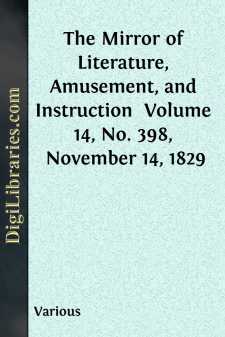Categories
- Antiques & Collectibles 13
- Architecture 36
- Art 48
- Bibles 22
- Biography & Autobiography 813
- Body, Mind & Spirit 142
- Business & Economics 28
- Children's Books 17
- Children's Fiction 14
- Computers 4
- Cooking 94
- Crafts & Hobbies 4
- Drama 346
- Education 46
- Family & Relationships 57
- Fiction 11829
- Games 19
- Gardening 17
- Health & Fitness 34
- History 1377
- House & Home 1
- Humor 147
- Juvenile Fiction 1873
- Juvenile Nonfiction 202
- Language Arts & Disciplines 88
- Law 16
- Literary Collections 686
- Literary Criticism 179
- Mathematics 13
- Medical 41
- Music 40
- Nature 179
- Non-Classifiable 1768
- Performing Arts 7
- Periodicals 1453
- Philosophy 64
- Photography 2
- Poetry 896
- Political Science 203
- Psychology 42
- Reference 154
- Religion 513
- Science 126
- Self-Help 84
- Social Science 81
- Sports & Recreation 34
- Study Aids 3
- Technology & Engineering 59
- Transportation 23
- Travel 463
- True Crime 29
The Mirror of Literature, Amusement, and Instruction Volume 14, No. 398, November 14, 1829
by: Various
Categories:
Description:
Excerpt
THE NATURALIST.
Castles, cathedrals, and churches, palaces, and parks, and architectural subjects generally, have occupied so many frontispiece pages of our recent numbers, that we have been induced to select the annexed cuts as a pleasant relief to this artificial monotony. They are Curiosities of Nature; and, in truth, more interesting than the proudest work of men's hands. Their economy is much more surprising than the most sumptuous production of art; and the intricacy and subtlety of its processes throw into the shade all the contrivances of social man: a few inquiries into their structure and habits will therefore prove entertaining to all classes of readers.
1. THE PRAYING MANTIS.
The Mantis is a species of cricket, and belongs to the Hemiptetera, or second order of insects. Blumenbach enumerates four varieties:—1. the Gigantic, from Amboyna, a span long, yet scarce as thick as a goose-quill, and eaten by the Indians. 2. Gonglyodes, from Guinea. 3. the Religious Mantis, or Praying Cricket. 4. Another at the Cape, and considered sacred by the Hottentots. The cut represents the third of these varieties.
It mostly goes on four legs, holding up two shorter ones. The hind legs are very long; the middle ones shorter. It is sometimes called the Dried and Walking Leaf, from the resemblance of its wing covering, in form and colour to a dry willow leaf; it is found in China and South America, and in the latter country many of the Indians believe that Mantes grow on trees like leaves, and that having arrived at maturity, they loosen themselves, and crawl or fly away.
Mr. T. Carpenter has recently dissected the head of this species, in which he found large and sharp cutting teeth; also strong grinding ones, similar to those in the heads of locusts: the balls at the ends fit into sockets in the jaw. The whole length of the insect is nearly three inches; it is of slender shape, and in its sitting posture is observed to hold up the two fore-legs slightly bent, as if in an attitude of prayer, whence its name; for this reason vulgar superstition has held it as a sacred insect; and a popular notion has often prevailed, that a child, or a traveller having lost its way, would be safely directed, by observing the quarter to which the animal pointed, when taken into the hand.
Its real disposition is, however, very far from peaceable: it preys with great rapacity on smaller insects, for which it lies in wait, in the first mentioned posture, till it siezes them with a sudden spring, and devours them. It is, in fact, of a very ferocious nature; and when kept with another of its own species, in a state of captivity, will attack its fellow with the utmost violence, and persevere till it has killed its antagonist. Roësal, a naturalist, who kept some of these insects, observes, that in their mutual conflicts, their manoeuvres very much resemble those of hussars fighting with sabres; and sometimes the one cleaves the other through, or severs the head from its body with a single stroke....












